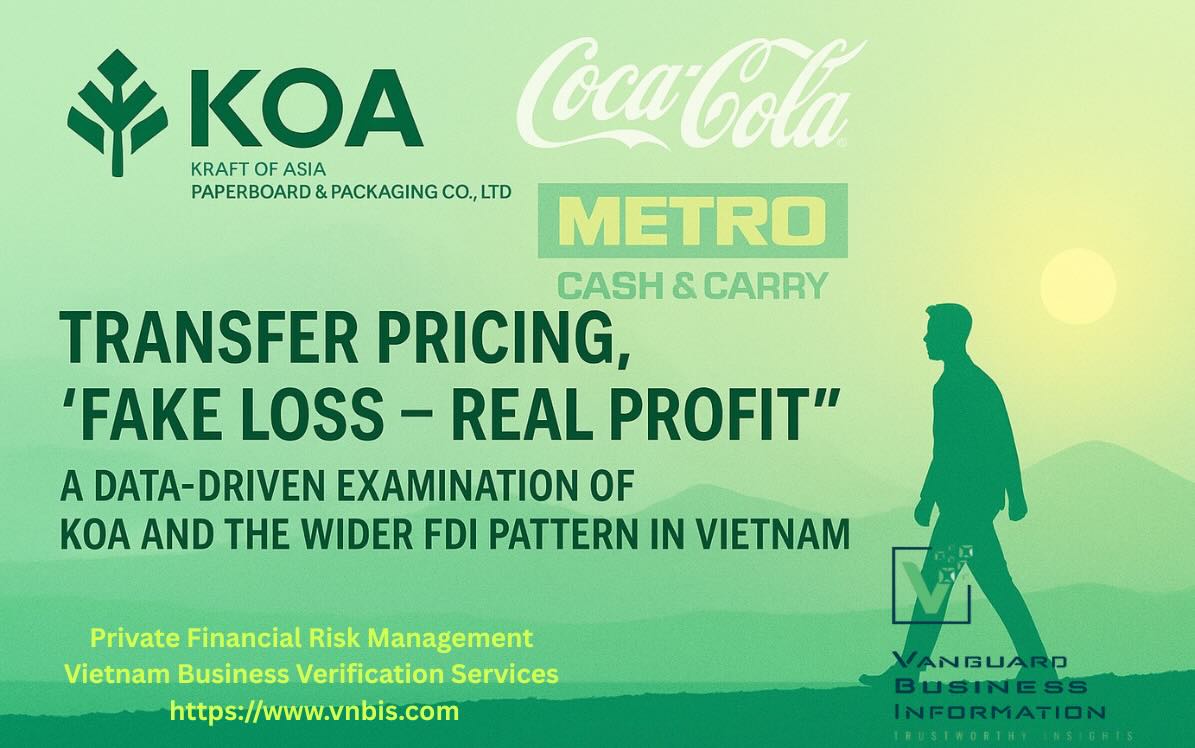Published Nov 2025
Transfer Pricing and “Fake Loss – Real Profit”: An Examination of KOA and the Wider FDI Pattern in Vietnam
Vietnam is witnessing a rare financial paradox where large foreign-invested corporations keep investing, growing, and dominating industries despite continually reporting losses on paper. Their tax payments remain negligible while their influence rises. This raises important questions about transfer pricing practices and the country’s long-term economic fairness.

Looking from a financial analyst's perspective, the financial statements of KRAFT OF ASIA PAPERBOARD & PACKAGING CO., LTD (KOA) raise several uncomfortable questions – not just about this specific project company, but about a broader, increasingly well-documented pattern of “fake loss, real profit” and profit-shifting among foreign-invested enterprises (FDI) in Vietnam.
The Ministry of Finance, State Audit, and major Vietnamese newspapers have repeatedly warned that many billion-dollar FDI projects are mainly financed through debt rather than genuine equity, creating a structural incentive to move profits offshore via inflated costs, intra-group interest payments, and related-party transactions. This national concern provides important context for understanding KOA’s financial profile.
Below is a structured breakdown of the issues, the questions KOA (and its offshore owners) must answer, and what Vietnam needs to do if it is serious about transparency and the rule of law.
1. Financial Signals That Defy Logic
1.1 Selling below cost for many years, a business model or a transfer-pricing mechanism?
For three consecutive years, KOA’s cost of goods sold (COGS) exceeds its net revenue, meaning KOA is structurally selling at a gross loss:
FY 2022
• Net sales: ~USD 2.41m
• COGS: ~USD 2.91m → gross loss
FY 2023
• Net sales: ~USD 99.37m
• COGS: ~USD 118.23m → gross loss
FY 2024
• Net sales: ~USD 99.94m
• COGS: ~USD 112.50m → gross loss
KOA’s gross margin is consistently negative double digits, while the industry benchmark is +10% or more.
No rational investor injects over USD 300 million into a project that loses money on every ton of paper sold. Such a pattern becomes economically plausible only when:
• Input prices (pulp, chemicals, machinery, energy) purchased from related parties are inflated, or
• Output prices for exports to related parties are undervalued, using both classic transfer-pricing techniques.
KOA should be required to explain its structurally negative margins and provide benchmarking against independent market prices.
1.2 Chronic losses, but rising equity and continuous expansion
KOA reports years of escalating accounting losses:
• FY 2020: –USD 3.60m
• FY 2021: –USD 4.82m
• FY 2022: –USD 7.54m
• FY 2023: –USD 38.19m
• FY 2024: –USD 30.18m
Cumulative retained losses exceed USD –84.7 million, yet owner’s equity suddenly jumps to nearly USD 99 million after a massive capital injection (over USD 70 million) from its BVI parent company.
Meanwhile, KOA continues to:
• Grow sales to ~USD 100m per year
• Expand its factory (CAPEX ~USD 5.2m in 2024)
• Maintain significant bank borrowings
Vietnamese media recently pointed out that many FDI megaprojects with significant investment are mainly financed through loans rather than true shareholder equity, creating an ideal setup for profit shifting and tax minimization. This pattern at KOA closely aligns with these national concerns.
1.3 Deeply negative working capital – yet banks and the owner continue funding
KOA’s liquidity profile is alarming:
• Current ratio: 0.55
• Working capital 2024: –USD 43.3m
• Working capital 2023: –USD 83.35m
• Operating cash flow: consistently negative (–USD 30.85m in 2024)
A company with:
• negative EBITDA
• negative EBIT
• negative CFO
• negative gross margins
• negative working capital
should normally struggle to borrow or attract more equity.
Yet KOA continues receiving both bank financing and fresh capital from its BVI shareholder.
In a transfer-pricing context, this makes sense: the true economic value may be captured offshore, with the Vietnamese entity used as a cost-accumulating unit.
1.4 Zero corporate income tax despite USD 100m annual revenue
KOA has paid zero corporate income tax for all years shown. Although this aligns technically with its declared losses, the macro-pattern is concerning:
• Over 50% of FDI firms in Vietnam report losses
• Many still expand aggressively
• Ministries warn about widespread “lỗ giả, lãi thật” (fake loss, real profit)
• Heavy use of intra-group loans, inflated costs, and internal transactions are documented repeatedly
KOA fits the profile perfectly: major investment, major revenue, major losses, zero tax.
2. Reasonable Questions
2.1 Transfer pricing and related parties
• What proportion of KOA’s raw materials, equipment, or services are purchased from related parties in BVI, Singapore, Hong Kong, or other low-tax hubs?
• How do these prices compare with market rates?
2.2 Royalty and service fees
• Are royalty, management, technical, or service fees paid to offshore affiliates?
• How were these benchmarked?
2.3 Negative gross margins
• Why has KOA never recorded a positive gross margin?
• Are selling prices constrained by intra-group pricing arrangements?
2.4 Capital injections
• Why inject tens of millions of dollars into a company that has never been profitable?
• What do consolidated profits look like at the parent-company level?
2.5 Tax contribution
• When will KOA begin contributing corporate income tax in Vietnam?
• How does KOA justify land use, environmental impact, and infrastructure burden if its tax contribution remains zero?
These are standard questions in any jurisdiction committed to protecting its tax base.
3. KOA Mirrors a Widely FDI Risks
Vietnam’s media and Ministry of Finance have highlighted multiple cases of transfer pricing and tax-base erosion, including:
• Metro Cash & Carry – significant tax adjustments due to related-party pricing
• Coca-Cola Vietnam – years of declared losses despite expansion, leading to major tax penalties
• FDI megaprojects using mostly borrowed capital (not equity) to create artificial interest expenses and push profits offshore
• FDI firms systematically using:
– inflated prices for intra-group raw materials
– high management or franchise fees
– under-priced exports to affiliates
– intra-group debt with non-market interest rates
These techniques create the phenomenon Vietnamese experts call “kỹ thuật lỗ giả, lãi thật” — show a loss in Vietnam, move actual profit abroad.
KOA’s pattern of offshore ownership (BVI, Panama, Cayman, Hongkong…), continuous losses, negative margins, zero taxes, but expanding operations, places it squarely in this national risk category.
4. Recommendations for Transparency
4.1 What KOA and similar FDI firms should be required to disclose
• Complete list of related parties, including entities in BVI, Cayman, Singapore, and Hong Kong
• Detailed pricing and terms for all related-party transactions
• Benchmarking studies for gross margins, interest rates, royalties, and service fees
• Segmented profit analysis by jurisdiction
• A credible roadmap to profitability and tax contribution in Vietnam
4.2 What regulators must strengthen
• Conduct thorough audits of “high revenue – chronic loss” FDI companies
• Enforce mandatory beneficial ownership disclosures
• Increase oversight of intra-group lending and interest deductions
• Implement Advance Pricing Agreements (APAs) for major manufacturers
• Impose significant penalties and back-tax adjustments when transfer-pricing abuses are detected
• Promote public transparency to prevent domestic firms from being disadvantaged by foreign firms engaging in tax-avoidance schemes
KOA, based on its financial profile, clearly meets multiple criteria for risk-based audits and increased scrutiny.
5. Final Message
KOA’s financial statements are not proof of wrongdoing.
But they are full of red flags that a responsible analyst, credit institution, or regulator cannot ignore:
• Continuous multi-year losses
• Negative margins
• Negative cash flows
• Under-capitalization followed by sudden capital injections
• Offshore ownership (BVI)
• Zero tax paid
• Ongoing expansion despite declared losses
In a country where more than half of FDI companies report losses while still growing, these patterns demand more challenging questions, clearer answers, and meaningful enforcement.
If Vietnam is serious about creating a transparent, rules-based business environment, it cannot allow shell-structured, perpetually loss-making entities to expand indefinitely while contributing little to the tax base and distorting fair competition.
As a leading provider of business intelligence and risk-assessment solutions in Vietnam, VNBIS specializes in delivering transparent, data-driven insights into both domestic and foreign-invested enterprises. If readers wish to explore KOA’s financial data in greater depth, including detailed ratio analysis, risk indicators, UBO screening, or potential transfer-pricing red flags
VNBIS is ready to provide the updated, full report and expert analytical support.


